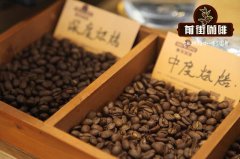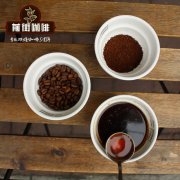Why does coffee taste bitter? How does roasting affect the bitterness of coffee?

The bitterness of coffee varies according to the degree of roasting. Of course, it also includes the original characteristics of beans, but to some extent it can be controlled by baking. Here, let's take a look at the "bitterness" of coffee beans that vary according to roasting conditions.
First of all, coffee is not bitter.
The coffee beans we usually see are roasted. The brown and fragrant smell is caused by the calories produced by baking, and the original "mung bean" of coffee does not have this color and aroma.
The beans are green to white before roasting, and there is no bitterness at the present stage of raw beans.
Flavor changes caused by baking
Raw coffee beans become "sour" due to roasting and gradually become bitter. Baking is divided into eight stages, and the intensity of sour and bitter tastes are also different. The degree of sour baking is very light, you can taste the light flavor.
On the other hand, if you want to enjoy strong bitter coffee, baking it to a strong coffee flavor that makes it deeply roasted can be tingling.
Painless "shallow baking ~ cinnamon baking"
Light baking (that is, the shallowest degree of baking) stops baking immediately after the process of reducing moisture (called "cooking") performed before the start of full baking. At this stage, there is no unique richness and light color of coffee, so it tastes like "is it really coffee?"
Even in the cinnamon baking stage, there is only a slight bitterness, and most of the taste is acidity. The impression of "fresh" is strong, and the progress of bitterness caused by baking is still weak. These lightly roasted coffee beans are rarely used in Japan, and many Scandinavian coffee shops are shipping them.
Sour "medium to high baking"
When baking moderately, you will feel a bitter taste, but the taste is still mainly sour. Because it is often used in American coffee, it has an American image that is easy to drink and refreshing.
High roasting, which is said to be the most common roasted coffee bean, is the stage when the balance between bitter and sour tastes begins to reach balance. It retains enough sour taste, but also has a slight and definite bitter taste, so it is usually the familiar taste of coffee.
Balanced "urban baking ~ citywide baking"
Urban baking, known as intermediate baking, has a good balance of bitterness and sour taste, and is a general baking condition that can be applied to a variety of coffee beans. With a good balance, you will strongly feel the sour taste of highly acidic beans and the deep bitterness of highly acidic beans. In Japan, baking conditions are also preferred.
When it comes to citywide baking, bitterness is sure to increase, and the ratio of sour to bitter will be reversed. You can enjoy it as a rich bitter coffee.

Royal Bakery "French Baking-Italian Baking"
From French baking, you can distinguish it into stages called deep baking. There was almost no sour taste, and the taste all turned into bitter coffee. By further baking and baking it into Italian baking, you will no longer feel sour.
The main bitter taste is the bitterness used in espresso and iced coffee, you can enjoy a strong bitter and smoky taste.
Summary of bitterness changes caused by baking
As the baking goes on, the bitterness that can hardly be seen in the slightly baked state gradually increases. Bitterness begins to be felt around city baking, and when it becomes complete city baking, bitterness reverses the sour taste. Those who want to taste bitterness as the main course can enjoy the strong bitterness by brewing coffee with roasted beans from all over the city.
Important Notice :
前街咖啡 FrontStreet Coffee has moved to new addredd:
FrontStreet Coffee Address: 315,Donghua East Road,GuangZhou
Tel:020 38364473
- Prev

How to distinguish between new beans, old beans, old beans and old beans of coffee? What's the difference between Chen Dou and Lao Dou?
The roasting date of coffee beans is very important, and the roasting date can be used to determine whether the coffee is in a delicious state or whether it has been stored for too long or improperly stored. But do you know the state of these coffee beans before they are roasted? After the fruit is harvested, coffee will be treated for several weeks, including the procedures of pulp removal, fermentation, drying, hand picking and so on.
- Next

What do you mean by city-wide baking? How to distinguish the roasting degree of coffee? The darker the color, the darker the baking.
City-wide baking is a stage that represents the degree of baking. Even if you use the same brand of coffee beans, the baking intensity will vary greatly in acidity and bitterness. Let's take a look at Full City Roast. The roasting of coffee beans can be divided into eight stages from light roasting to deep roasting. Light baking cinnamon baking moderate baking deep baking city baking whole city baking
Related
- Beginners will see the "Coffee pull flower" guide!
- What is the difference between ice blog purified milk and ordinary milk coffee?
- Why is the Philippines the largest producer of crops in Liberia?
- For coffee extraction, should the fine powder be retained?
- How does extracted espresso fill pressed powder? How much strength does it take to press the powder?
- How to make jasmine cold extract coffee? Is the jasmine + latte good?
- Will this little toy really make the coffee taste better? How does Lily Drip affect coffee extraction?
- Will the action of slapping the filter cup also affect coffee extraction?
- What's the difference between powder-to-water ratio and powder-to-liquid ratio?
- What is the Ethiopian local species? What does it have to do with Heirloom native species?

